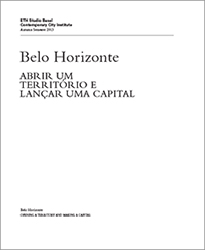Belo Horizonte - Opening a Territory and Making a Capital

Professors: Roger Diener, Marcel Meili
Assistants: Mathias Gunz, Liisa Gunnarsson, Vesna Jovanovic, Christian Müller Inderbitzin
In collaboration with PUC Minas (Pontíficia Universidade Católica de Minas Gerais) and UFMG (Universidade Federal de Minas Gerais): Prof. Vanessa Brasileiro, Prof. Rita de Cássia Lucena Velloso, Prof. Roberto Luis de Melo Monte-Mor, Prof. Jupira Mendonça, João Tonucci, Rogério Palhares Zschaber Araújo
Special thanks to: Patrícia Capanema Fernandes (freelance architect and researcher, Belo Horizonte); Ana Carolina Neves (Vale, Belo Horizonte); Hans-Christian Angele (GEOKLOCK, São Paulo), Alexandre Brito (Sistema FIEMG, Belo Horizonte), Maro Forster (consultant COPASA, Belo Horizonte), Walter Hunter (Hunter Consultoria Ltd, Belo Horizonte), Marta Lagreca, Elisabete Franca (DIAGONAL, São Paulo), Dieter Max Pfeiffer (architect, Basel), Thomas Häuser (reporter Radio SRF 2 Kultur, Basel/Zürich), Mabe Bethonico (artist, Geneva/Belo Horizonte), Daniel Faust (Brasilea Stiftung, Basel), Fernando de Mello Franco (Urban Secretary of Development Sao Paulo, Prefeitura SP, ITDP), Mauricio Kazufuni Kamada, Paulo José Galli, Nédio Henrique Rosseli Filho (Caixa, Minha Casa Minha Vida program)
Graphic Designer: Absolut Agentur, St. Gallen
Editorial Supervisors: Vesna Jovanovic, Liisa Gunnarsson
Editorial Assistant: Jonathan Sedding
Druckerei Weber GmbH & Co., Lörrach.
Published by ETH Studio Basel: Contemporary City Institute, Basel 2015

We have ventured this year to the interior of Brazil, to a state called Minas Gerais, abbreviated from ‘Minas dos Matos Gerais’, which literally means ‘Mines of the General Woods’ and refers to two large geographical spaces dominant in this (very large) state: the Sertão - the dry Brazilian highlands - and what has now come to be called the Quadrilátero Ferrífero - a mineral-rich area that for centuries has seen urbanization activity in the form of mining towns, and cargo infrastructure. This is also the place that the city of Belo Horizonte is capital of - today the third most populous metropolitan region of Brazil, right after São Paulo and Rio de Janeiro, hosting twenty cities and 5.5 mil. inhabitants. Compared to the extensive activities that have been happening on the land this metropolis is very young, founded in 1897, and stands on top of this land in a very complex series of relations to its surroundings, performing its metropolitan duty, but also in instances ambiguously autonomous, disconnected even. Our understanding of cities emerging and reigning over extensive physical domains - territories - seems to not apply here at all: an alluring case study to broaden our knowledge on contemporary forms on urbanization, and the ways in which cities relate back to their (hinter)land. A crucial element of this research was a joint two-week expedition, in and around the city of Belo Horizonte, observing the different city expansions that appropriate the nearby landscape, and start to overlap with a series of activities that have permeated the land for centuries - the agriculture and livestock herding, and the mining. Each team operated individually covering a topic, seeking out sites where they could observe and understand these complex overlaps, and the new phenomena that the particular conditions create. This book is a repackaging of all the discoveries, curated to tell a tale of Contemporary Minas Gerais.

